Input
On the Input tab of the Drillhole Cones of Uncertainty form, choose a drillhole database or a string file input option.
Drillhole Database
Double-click (F3) to select
Select the Filter check box if you want to apply a filter to the database. Enter a filter number in the adjacent response. Double click (F3) to see a list of existing filters. Right click (F4) to open the dialog box where you can create a new filter.

String
Alternatively, select the String radio button and use the File field to select the input file containing the strings you want to use to identify fill solids and unfilled solids in the wireframe set.
Set the file type using the Type drop down.
Use the Filter check box to enable the filter and click the button at the right.
Select the form set from the filter dialog that opens - or create a new form set if none are defined.

Hole name field
Can be used to optionally select the field in the input file which contains the Hole name.
East field
Used to select the field in the input file which contains the East values for your string.
North field
Used to select the field in the input file which contains the North values for your string.
RL field
Used to select the field in the input file which contains the RL values for your string.
Join Field
In forms that require polylines as an input, the values in this field define whether the data points in the input file should be joined by a line. If successive records have the same value in this field, a line will join the points. If two-factor topology is required, the values in a String field may also be used to segment the lines.
String field
In most forms, the String field is an optional generic attribute used to store a secondary input such as a code. Traditionally, this field has also been used with the Join field to define whether data points should be joined by a line, or strung, hence the name.